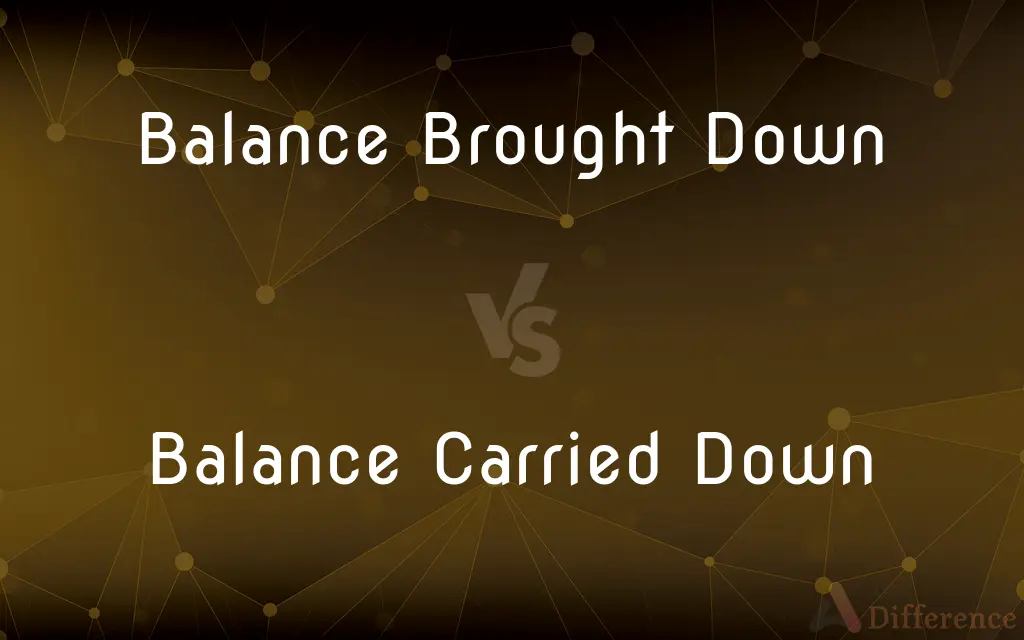Balance Brought Down vs. Balance Carried Down — What's the Difference?
By Tayyaba Rehman — Published on October 3, 2023
Balance Brought Down (B/b) refers to the opening balance of a new accounting period, while Balance Carried Down (B/c) is the closing balance from an accounting period, moved to the next one.

Difference Between Balance Brought Down and Balance Carried Down
Table of Contents
ADVERTISEMENT
Key Differences
Balance Brought Down (B/b) is often an imperative aspect as it is essentially the opening balance on the ledger account and is placed on the debit or credit side depending on the nature of the account at the commencement of the accounting period. On the other hand, Balance Carried Down (B/c) is crucial as it represents the closing balance of the ledger account, appearing on the side where the account is not balanced (debit or credit) at the conclusion of the accounting period.
In the context of Balance Brought Down, it forms a commencement point for financial transactions in the respective period and its value is equal to the closing balance of the previous accounting period, providing continuity in the accounting records. Contrarily, Balance Carried Down acts as a figure that ensures the equality of the debit and credit sides of a ledger, carrying forward the unbalanced amount to the next period.
The Balance Brought Down is critical in understanding the financial position at the beginning of a period and aids in tracking and analyzing the financial movements and status of an account. Whereas Balance Carried Down is vital for maintaining the consistency and accuracy of financial records, ensuring that accounts are balanced and prepared for the subsequent period.
For Balance Brought Down, it provides an initial input for financial analyses and is instrumental in ensuring accurate financial tracking throughout the period. Alternatively, Balance Carried Down is pivotal in closing the books, signaling the end of an accounting period and preparing the account for the future transactions of the next period.
In situations, Balance Brought Down can facilitate the derivation of figures like profit or loss for the period by considering its position along with the financial transactions. While in the case of Balance Carried Down, it facilitates smooth transitioning of accounts from one period to another by providing a conclusive figure that moves forward to the next period.
ADVERTISEMENT
Comparison Chart
Position in Ledger
Beginning of a new accounting period
End of the current accounting period
Usage
Used to commence the accounting period
Used to conclude the accounting period
Presentation in Account
Displayed on the side where the next period begins
Placed opposite to the total to balance the account
Purpose
To continue the account into the next period
To balance the account for closure
Calculation Relevance
Derived from the previous period’s B/c
Determined by the current period’s transactions
Compare with Definitions
Balance Brought Down
Starting balance of a new accounting period.
The Balance Brought Down from the previous month was $5,000.
Balance Carried Down
Closing balance transferred to the next period.
The books showed a Balance Carried Down of $6,000.
Balance Brought Down
Commencing balance for financial tracking.
$3,000 was noted as the Balance Brought Down in January.
Balance Carried Down
Closing amount on a ledger for the period.
A $2,000 Balance Carried Down was reported in March.
Balance Brought Down
Initial financial position on an account.
The ledger displayed a Balance Brought Down of $4,500.
Balance Carried Down
The balance ensuring ledger equality.
The ledger had a Balance Carried Down of $4,000.
Balance Brought Down
Carrying forward closing balance to a new period.
The Balance Brought Down for the quarter was $1,000.
Balance Carried Down
Final figure moved forward to a new period.
His account indicated a Balance Carried Down of $8,000.
Balance Brought Down
Opening amount on the ledger in a period.
His account showed a Balance Brought Down of $2,000.
Balance Carried Down
End figure shifted to the next accounting period.
The Balance Carried Down for the fiscal year was $9,000.
Common Curiosities
What does Balance Brought Down represent?
Balance Brought Down represents the opening balance for a new accounting period.
Is Balance Carried Down the closing balance?
Yes, Balance Carried Down is the closing balance for the current accounting period.
Does Balance Brought Down appear on the debit or credit side?
Balance Brought Down can appear on either the debit or credit side, depending on the previous period's closing balance.
How is Balance Brought Down derived?
Balance Brought Down is derived from the Balance Carried Down of the previous period.
What role does Balance Carried Down play in ledgers?
Balance Carried Down helps to balance the ledger and carry forward the closing balance to the next period.
Share Your Discovery

Previous Comparison
Immunoprecipitation vs. Coimmunoprecipitation
Next Comparison
Counselor vs. TherapistAuthor Spotlight
Written by
Tayyaba RehmanTayyaba Rehman is a distinguished writer, currently serving as a primary contributor to askdifference.com. As a researcher in semantics and etymology, Tayyaba's passion for the complexity of languages and their distinctions has found a perfect home on the platform. Tayyaba delves into the intricacies of language, distinguishing between commonly confused words and phrases, thereby providing clarity for readers worldwide.
















































